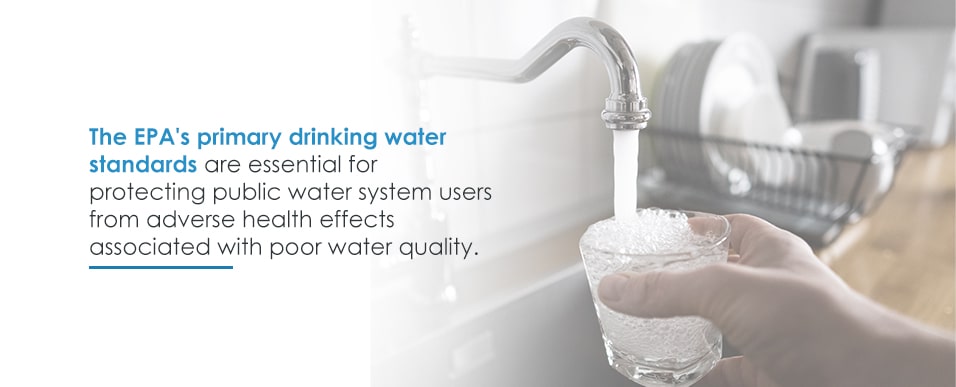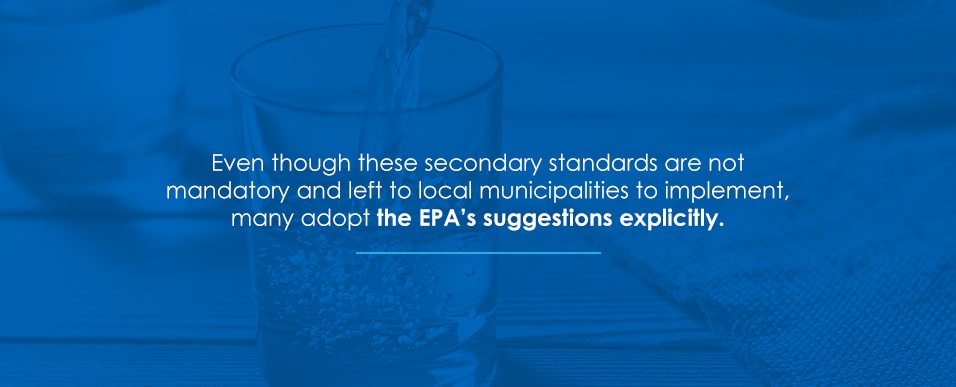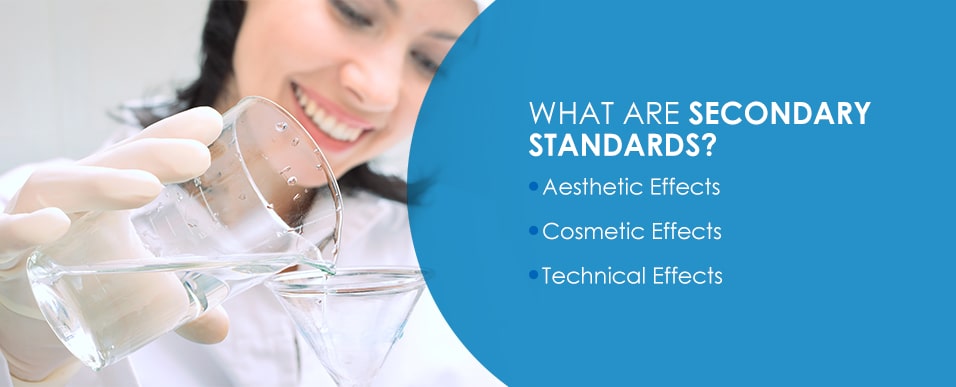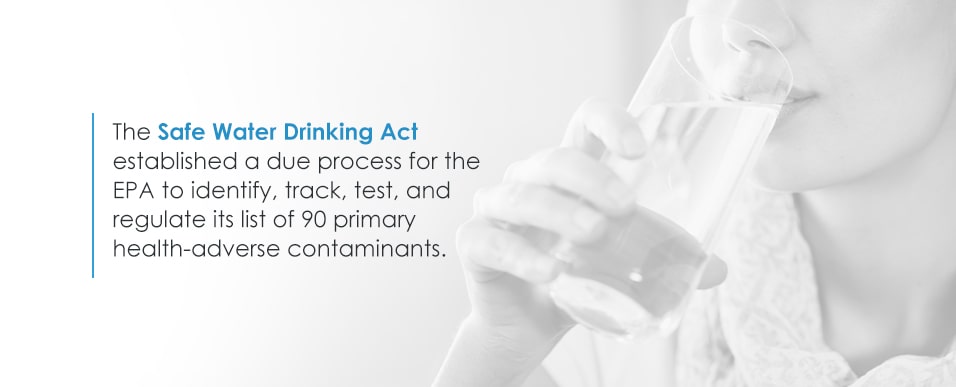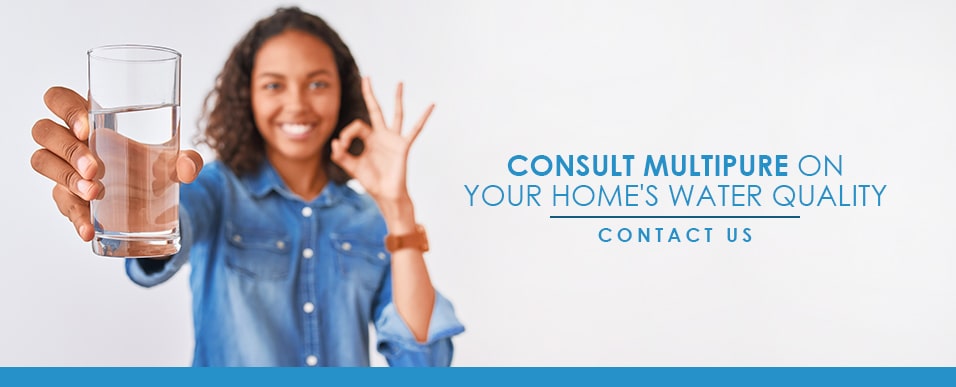Guide to EPA Drinking Water Standards
Posted by Kenton Jones on Aug 4th 2021
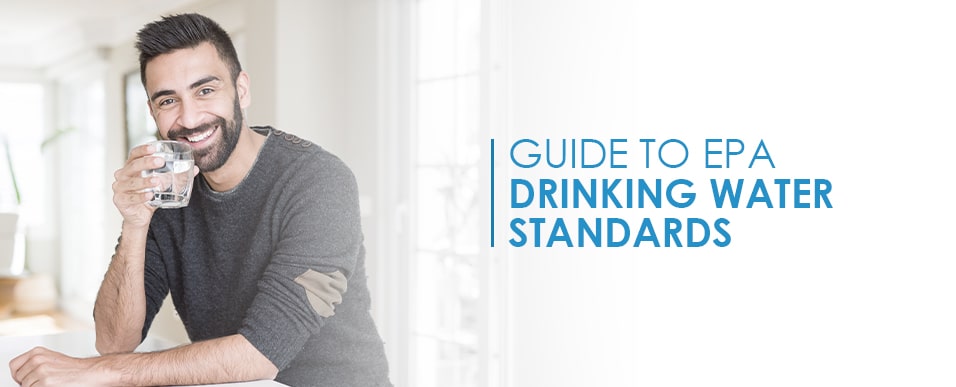
Water problems don’t end in Flint, Mich. While the Midwest city has become synonymous with the drinking water crisis that captured the attention of the nation, mounting teams of researchers have turned to the Environmental Protection Agency’s (EPA) own three-decades of amassed water-standard violations to grasp the extent of today’s predicament. The results are far from settling.
Studies have found that between 1982 to 2018, nearly
one in four Americans received water from a contaminated, undertested, or untested system. These violations touch every state, hitting rural and economically disadvantaged areas the hardest. What’s more, these numbers are projected to worsen.
Such findings only emphasize the importance of the EPA’s own drinking water regulations, as well as the local and national agencies responsible for administering them. From tracking lead levels due to aging pipelines to tracing amounts of nitrates, bacteria, and arsenic, the EPA sets the standard for what poses water-based health complications for the public — as well as what we can do about them.
Contaminants the EPA Regulates
The EPA currently oversees two classifications of water standards that set the parameters for safe and legal drinking water in the U.S.:
- National Primary Drinking Water Regulations (NPDWR)
- National Secondary Drinking Water Regulations (NSDWR)
Each of these two standards contains a list of substances deemed of vital and ancillary importance to test for, monitor, and regulate in the nation’s drinking water.
However, there is one key difference between the two — substances in the primary category are proven to correlate with human health concerns when found at or above maximum contaminant levels (MCLs), while those in the secondary level should be tested not necessarily for health risks, but for their effects on the taste, look, and smell of drinking water. The EPA's secondary drinking water standards are non-enforceable recommendations, while the primary drinking water regulations, which do relate to health, are enforceable under the law.
Primary and secondary conditions, as well as their associated contaminants, are discussed in full below.
Primary Drinking Water Standards (NPDWR)
The EPA's primary drinking water standards are essential for protecting public water system users from adverse health effects associated with poor water quality. They ensure the safety of our public drinking water by limiting the contaminants permitted in it.
What Are Primary Standards?
The EPA’S NPDWR standards are the authoritative, enforceable laws governing contaminant levels within the U.S.'s drinking water systems. Most importantly, the NPDWR identifies a list of water chemicals, substances, and organic contaminants that, in high and sustained doses,
have been shown to pose significant health risks to humans, particularly children and pregnant women. It then outlines safe purification and treatment techniques to reduce those contaminants.
These standards first and foremost protect the public. Drinking water with substances at or above the EPA's set MCLs are associated with many health conditions including cancer, digestive disruptions, anemia, and reproductive problems to decreased kidney and cardiovascular functions, neurodevelopment complications, and learning and behavioral issues when exposed in the long-term. The standards identify each of the regulated contaminants, enumerate the potential public health risks caused by short- or long-term exposure, and indicate common sources for each contaminant on the list.
Today, the EPA regulates a list of
nearly 90 primary drinking water contaminants. These health-adverse contaminants are broken down into the following six categories, each with their own essential differences.
1. Microorganisms
Examples: E. coli and legionella (bacteria), cryptosporidium and Giardia (parasites), enteric pathogens (viruses)
Microorganisms are living entities and microscopic organisms that exist in water. There are three types of microorganisms — bacteria, parasites, and viruses. The first, bacteria, range from naturally occurring species that live in water and are not harmful in and of themselves to more serious strains caused by animal or human waste runoff. Parasites and viruses are pathogens carried on waste as well, passed from infected people or animals and leached into a water source. Of the three, parasites and bacteria tend to survive longest in water but can be mitigated by more treatments. Drinking water samples that display lower concentrations of bacteria indicate a better-maintained, safer-quality water source.
2. Disinfectants
Examples: chlorine, chloramine, chlorine dioxide
Disinfectants are water additives that, in controlled moderation, can be used as a water treatment to mitigate the growth of harmful microbes. The EPA endorses certain disinfectant treatments to prevent water-borne illnesses. However, there are both
permitted and unpermitted forms and levels of water disinfectants. Those permitted must adhere to the MCLs outlined by the EPA, plus will be governed based on use or application. For example, different water disinfectants are allowed for urban residential drinking water versus agricultural irrigation systems.
3. Disinfection Byproducts (DBPs)
Examples: chloroform, bromate, chlorite
As the name suggests,
disinfection byproducts are the result of chemical interactions that take place when water disinfectants react with other natural substances in that water. This results in the creation of new modified compounds that are often carcinogenic. In simpler words, if a disinfectant treatment is employed to purify water, a DBP will likely occur. Currently, the EPA regulates safe levels of five kinds of DBPs to balance the need for microbe purification alongside the need to keep DBPs at safe concentrations.
4. Inorganic Chemicals
Examples: fluoride, mercury, lead, arsenic, nitrates and nitrites, many metal periodic table elements
The largest and most well-known contaminants on the EPA’s list, inorganic chemicals are pollutants and toxins that do not naturally exist in water but can be a result of natural or human contamination. While some, like fluoride, are considered by some people to be beneficial to health in micro-doses, too-high concentrations of inorganic chemicals are
the leading cause of water contamination in the United States today.
5. Organic Chemicals
Examples: benzene, tetrachloride, most dichlorobenzene compounds
Organic chemicals comprise the portion of the NPDWR dedicated to human-made and synthetic chemical compounds. These most often contaminate water sources during improper agricultural or industrial run-off, ground leaching, and discharge of things like pesticides, herbicides, paints, and fuels.
6. Radionuclides
Examples: uranium
Radionuclides are the final compound category regulated by the EPA’s primary water standards. They constitute radioactive particles that emit radiation and have been tied to increased risks of cancer in humans.
Radionuclides leach into water typically through two causes — the erosion of natural radioactive mineral deposits or the decay of man-made radioactive mineral deposits.
Secondary Drinking Water Standards (NSDWR)
The
EPA’s secondary drinking water standards offer further guidance and direction on the aesthetic quality of public drinking water.
While primary standards are federal-level, legally binding mandates focused entirely on the public’s health, secondary standards are meant to zoom outward, taking a broader look at what makes public drinking water appealing and accessible to that public. Even though these secondary standards are not mandatory and left to local municipalities to implement, many adopt the EPA’s suggestions explicitly.
What Are Secondary Standards?
The secondary drinking water standards are recommendations rather than rules — they supplement the primary standards by providing guidance for public water systems. They contain lists of contaminants, recommended MCLs, and the noticeable effects that occur if the contaminant levels exceed the recommended MCLs. They help water facilities address less critical contaminants, such as those that affect taste, smell, and color without posing health concerns.
This is the essential difference between primary and secondary drinking water standards in the U.S. — enforceable versus non-enforceable, laws versus guidelines. Again, while primary measures account for nearly 90 health-adverse contaminants, secondary measures only account for 15 non-health adverse ones.
Secondary drinking water standards are categorized in the following three domains:
1. Aesthetic Effects
These are contaminants that affect the taste, color, and smell of drinking water — often unpleasantly — but do not contain health-jeopardizing properties. At their current EPA-set MCLs, these “aesthetic” compounds include iron, manganese, copper, zinc, certain sulfates, and a few more that can lend water everything from a metallic taste to a sour smell. Some of the most commonly cited civic water complaints have to do with the aesthetics of municipal water, particularly color. These are usually harmless, but at their worst may indicate levels of contaminant buildup that fall into primary standards.
2. Cosmetic Effects
Cosmetic effects refer to side effects from drinking tap water that don't cause harm or damage to the body. The most prevalent cosmetic water effect is tooth spotting or discoloration, often seen in children due to fluoride overexposure during formative tooth development. With
40 to 70 percent of Americans’ total fluoride intake achieved by drinking tap water, fluoride level is a cosmetic contaminant that many states and cities regularly test.
3. Technical Effects
Technical effects on drinking water concern not necessarily the water itself, but possibly damaged or malfunctioning water equipment, as well as previous forms of purification methods that are no longer working. Technical effects most often strike in the form of scale deposits or corroding water pipes. This will imbalance the drinking water’s pH levels to undesirable results, with low pH making water taste carbonated and high pH lending it a metallic, even bitter taste.
Again, it bears repeating that these secondary standards were set up by the EPA to quell public misunderstandings on what constitutes safe water. Understandably, people are unlikely to drink tap water that appears cloudy, discolored, or just plain smells. NSDWSR aims to directly address and calm such concerns straight from an authoritative source.
How the EPA Develops and Reviews Their Safe Drinking Water Standards
The
Safe Water Drinking Act established a due process for the EPA to identify, track, test, and regulate its list of 90 primary health-adverse contaminants.
Passed in the mid-1970s, this piece of legislature shapes how the EPA develops and reviews its safe water standards. It follows the formal procedure of “Regulatory Determination” to resolve what gets added to the NPDWR’s list, as well as when regulations take effect and permissible MCLs for any newly listed contaminants.
New Contaminant Review Process: Regulatory Determination Steps
The regulatory determination process sits at the heart of how the EPA makes safe drinking water announcements and provisions.
In it, contaminants under question are first filed by private or public entities and added to the
EPA’s official Contaminant Candidate List (CCL).
The EPA is mandated to review and publish the CCL at least once every five years. During that five-year review, they must also make official rulings on at least five in-question contaminants, formally assigning them to one of three categories:
- Primary: to be regulated
- Secondary: to issue a health advisory
- Neither: not a problematic contaminant
For the EPA to classify a contaminant candidate as primary and therefore set a legal MCL, the regulatory determination process must prove it checks three health-adverse benchmarks:
- The contaminant must be shown, without reasonable doubt, to pose adverse health risks for humans.
- The contaminant has been shown to occur or has a high likelihood of occurring across public water systems at rates frequent enough to warrant widespread health concerns.
- Regulating the contaminant serves to meaningfully protect the public served by drinking water systems, with regulation the most effective opportunity to do so.
What Happens When a Contaminant Is Deemed Primary?
If a CCL contaminant is reviewed and found to fit all three of regulatory determination’s benchmarks, the EPA initiates
the following primary implementation process, ultimately resulting in the contaminant’s public regulation.
- Sets an enforceable MCL: Using its data, the EPA will set the formal maximum amount of a contaminant that can be in water without triggering known or anticipated health consequences. The EPA takes into special account how the contaminant affects specific populations — namely infants, children, pregnant women, the elderly, and those with chronic diseases or compromised immune systems — when devising an MCL.
- Sets a treatment standard: The EPA then sets strategies on how to reduce or eliminate a target contaminant. There are dozens of treatment strategies and standards endorsed by the EPA today.
- Monitor the timeline: Primary regulation updates go into legal effect three years after their EPA ruling. If capital investments are required by municipalities to comply with the new standards and treatments, they may petition for an additional two years to meet compliance.
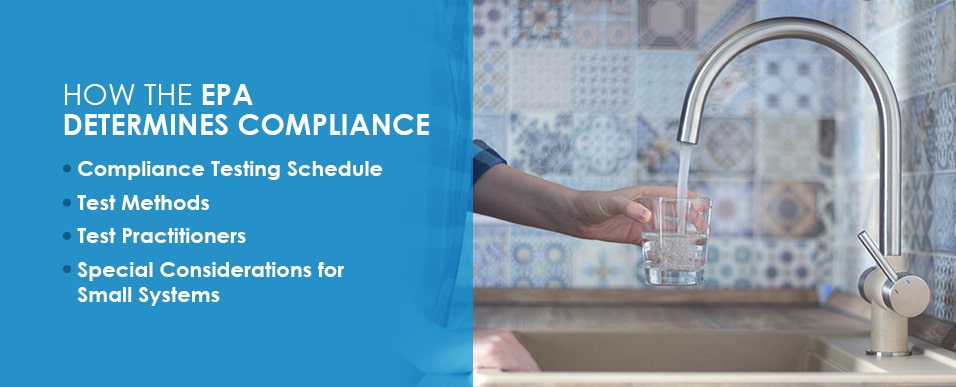
How the EPA Determines Compliance
The purpose of the EPA’s drinking water standards rests on the ability to enforce its findings. Indeed, there wouldn’t be much of a point to the years of research and collaborative efforts that go into devising these standards in the first place without equally diligent compliance measures.
Through joint local and federal efforts, the EPA uses the following to
determine water standard compliance:
1. Compliance Testing Schedule
Community water suppliers are legally accountable to provide at least one annual comprehensive water compliance test a year. The results of these tests must be sent to all area customers in a Consumer Confidence Report, or CCR. However, the Safe Drinking Water Act denotes certain
primary contaminants must be tested for quarterly, monthly, or even daily to ensure readings at or below MCLs.
2. Test Methods
There are two ways institutions can test the compliance of water.
First, there is the EPA’s own set analytical methodology. The EPA provides an in-depth water testing procedure for municipalities and their partners to follow, which it updates during its five-year CCL ruling. This
federal water analytical methodology includes the following:
- How to collect and store water samples
- How to properly separate and identify the various components and compounds found in water samples, with special attention on analyzing the six NPDWR categories. Each of these six primary categories will be then individually measured using outlined technology and equipment.
- Compare findings with the EPA’s set MCLs
- Report findings to relevant internal and external constituents
- Document and file the entire procedure for future records
Second, agents can follow their own testing methods so long as they’re approved by the
EPA’s Drinking Water Alternate Test Procedure Program and detail similar steps from above. Failure to adhere to either the EPA’s Analytical Methodology or have an EPA-approved Alternate Test Program automatically makes a water system non-compliant.
3. Test Practitioners
There are several institutions the EPA allows to conduct formal water standards compliance tests. So long as these institutions follow one of the two approved test methods and document that approval, they are permissible practitioners. These include:
- Government organizations
- Universities
- Private yet formally inspected laboratories
- Commercial vendors, also formally inspected
4. Special Considerations for Small Systems
The EPA recognizes geographic and economic restrictions to compliant water testing that may clash with an area’s ability to supply local constituents with affordable drinking water.
Due to many factors, it may be too expensive for municipalities — particularly rural ones — to have the equipment or staffed personnel to monitor water samples actively. In such petitioned cases, known as small systems, the EPA grants tailored sets of technology and purification treatments more feasible for these areas.
There are three categories of small systems the EPA delivers prorated compliance tests to:
- Those serving 25 to 500 people.
- Those serving 501 to 3,300 people.
- Those serving 3,301 to 10,000 people.
Small public drinking water systems serve nearly 90 percent of the U.S. population. The EPA generally recommends small systems employ point-of-entry or point-of-use treatment devices to keep these customers’ water in compliance, as well as provide packaged or modular filtration systems to bolster treatment efforts.
Consult Multipure on Your Home's Water Quality
You should have confidence in the safety and security of your home’s drinking water.
Something as basic yet essential to our health requires information and resources on-demand, answering your questions, and satisfying your concerns.
That’s where Multipure steps in.
Multipure is on a mission to bring the highest-quality yet accessible and affordable water to individuals and families across the nation.
Reach out today with any questions on the state of your home’s water quality and how we can help.


